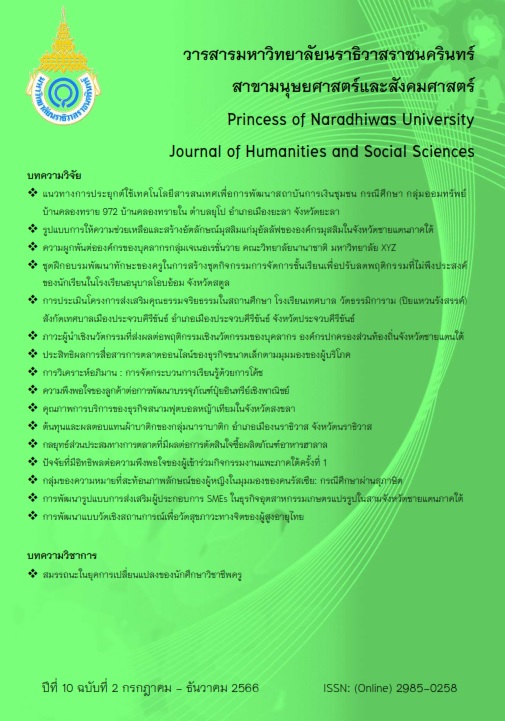The Development of a Situation Test to Measure Psychological Well-Being of the Thai Elderly
Main Article Content
Abstract
The objectives of this research were 1) to develop a situational measurement approach to assess the mental well-being of Thai elderly people with accurate and reliable quality, 2) to examine the structural accuracy of situational measurements to measure the mental well-being of Thai elderly people. The population used in this research includes Thai male and female aged between 60-85 years. The research utilized a multi-stage sampling method and obtained a sample size of 1,000 elderly people. The research instrument was a situational test to measure psychological well-being of Thai elderly people. The instrument quality was assessed through item-total correlation and Cronbach's alpha coefficient analysis. Data analysis was conducted using Exploratory Factor Analysis (EFA) and Confirmatory Factor Analysis (CFA) with the statistical software Mplus.
The results showed that 1) The development of a situational measurement test to measure mental well-being of the Thai elderly based on the factor analysis, consists of 4 factors: positive relationships, positive emotions, psychological resilience and self-esteem. Each factors has the Eigen Value over 1.00 and can explain the mental health assessment of the Thai elderly at 50.971 %. 2) The confirmatory factor analysis showed that measurement models align with empirical data. The model coherence index is as follows: χ2= 69.695 df = 59 χ2 / df = 1.18 p-value = 0.1608 CFI = 0.972 TLI = 0.956 RMSEA = 0.019 and SRMR = 0.034
Article Details

This work is licensed under a Creative Commons Attribution-NonCommercial-NoDerivatives 4.0 International License.
References
กรมกิจการผู้สูงอายุ. (2564). ทะเบียนโรงเรียนผู้สูงอายุปี 2564. สืบค้นจาก https://www.dop.go.th/ thai/service_information/1/14
กรมสุขภาพจิต. (2555). คู่มือความสุข 5 มิติสาหรับผู้สูงอายุ. กรุงเทพฯ: โรงพิมพ์ชุมนุมสหกรณ์การเกษตรแห่งประเทศ.
กรมสุขภาพจิต กระทรวงสาธารณสุข. (2561). แนวทางการดูแลสังคมจิตใจของผู้สูงอายุเพื่อป้องกัน
ปัญหาสุขภาพจิต. กรุงเทพฯ: บียอนด์ พับลิชชิ่ง.
กัลยา วานิชย์บัญชา. (2557). การวิเคราะห์สมการ โครงสร้าง (SEM) ด้วย AMOS (พิมพ์ครั้งที่ 2).
กรุงเทพฯ: สามลดา.
คัคนางค์ มณีศรี. (2550). แบบวัดสุขภาวะทางจิต. คณะจิตวิทยา จุฬาลงกรณ์มหาวิทยาลัย.
ดวงพร ภาคาหาญ.(2560).การศึกษาความสัมพันธ์ระหว่างการเห็นคุณค่าในตนเองกับระดับสุขภาพจิต
ของผู้สูงอายุ ในโรงเรียนผู้สูงอายุ เขตรับผิดชอบศูนย์สุขภาพชุมชนเขตเมือง รพ.แพร่ (ร่องซ้อ). วารสารโรงพยาบาลแพร่, 25(1),13-23.
พิชิต ฤทธิ์จรูญ.(2545) หลักการวัดและประเมินผลการศึกษา (พิมพครั้งที่ 2). กรุงเทพฯ: เฮาส ออฟ เคอรมิสท์.
มูลนิธิสถาบันวิจัยและพัฒนาผู้สูงอายุไทย (มส.ผส.). (2564). สถานการณ์ผู้สูงอายุไทย พ.ศ. 2563. นครปฐม: สถาบันวิจัยประชากรและสังคม มหาวิทยาลัยมหิดล.
มูลนิธิสถาบันวิจัยและพัฒนาผู้สูงอายุไทย (มส.ผส.). (2565). สถานการณ์ผู้สูงอายุไทย พ.ศ. 2564. นครปฐม: สถาบันวิจัยประชากรและสังคม มหาวิทยาลัยมหิดล.
วัลลภ รัฐฉัตรานนท์. (2556). วิธีและเทคนิคในการวิจัยทางรัฐศาสตร์. กรุงเทพฯ : เสมาธรรม.
สิน พันธุ์พินิจ. (2554). เทคนิคการวิจัยทางสังคมศาสตร์ (พิมพ์ครั้งที่ 2). กรุงเทพฯ : วิทยพัฒน์
สุภมาส อังศุโชติ, สมถวิล วิจิตวรรณา, และรัชนีกูล ภิญโญภานุวัฒน์. (2552). สถิติวิเคราะห์สำหรับการวิจัยทางสังคมศาสตร์และพฤติกรรมการศาสตร์ เทคนิคการใช้โปรแกรม Lisrel. (พิมพ์ครั้งที่ 3). กรุงเทพฯ: เจริญดีมั่นคงการพิมพ์.
อรพินทร์ ชูชม, พรรณี บุญประกอบ, มนัส บุญประกอบ, อุษา ศรีจินดารัตน์, และสุชาดา สุธรรมรักษ์.(2563).การพัฒนาแบบวัดสุขภาวะทางจิตสาหรับผู้สูงอายุไทย. วารสารศรีนครินทรวิโรฒวิจัยและพัฒนา (สาขามนุษยศาสตร์และสังคมศาสตร์), 12(23), 112-124.
อุบลทิพย์ ไชยแสง และนิวัติ ไชยแสง. (2566). การศึกษาความสัมพันธ์ระหว่างการเห็นคุณค่าในตนเอง แรงสนับสนุนทางสังคมกับสุขภาวะทางจิตของผู้สูงอายุกลุ่มติดบ้าน ในเขตอำเภอเมือง จังหวัด
ยะลา.วารสารวิชาการสาธารณสุขชุมชน, 9(1), 160-169.
เอมอร จังศิริพรปกรณ์. (2550). การวัดและประเมินผลการศึกษา. กรุงเทพฯ: โรงพิมพ์แห่งจุฬาลงกรณ์มหาวิทยาลัย.
Adams, T., Bezner, J., & Steinhardt, M. (1997). The conceptualization and measurement of perceived wellness: Integrating balance across and within dimensions. American Journal of Health Promotion,11(3), 208-18.
Diener, E. (1984). Subjective well-being. Psychological Bulletin, 95(3), 542-575.
Hair, J.F., Black, W.C., Babin, B.J. & Anderson, R.E. (2010). Multivariate Data Analysis (7thed.).
Pearson: New York
Henderson, L. W., & Knight, T. (2012). Integrating the hedonic and eudaimonic perspectives to more wellbeing and pathways to wellbeing. International Journal of Wellbeing, 2(3), 196-221.
Ryan, R. M., & Deci, E. L. (2001). On happiness and human potentials: A review of research on hedonic and eudaimonic well-being. Annual Review of Psychology, 52, 141-166.
Ryff, C. D. (1989). Happiness Is Everything, or Is It? Explorations on the Meaning of Psychological Well-Being. Journal of Personality and Social Psychology, 57(6), 1069-1081
Ryff, C. D., & Keyes, C. L. M. (1995). The structure of psychological well-being revisited. Journal of Personality and Social Psychology, 69(4), 719-727.
Seligman, M. E. P. (2011). Flourish: A visionary new understanding of happiness and well-being. New York, NY: Atria Books.


